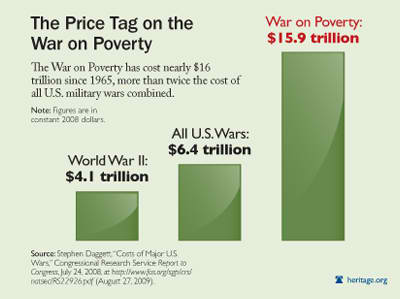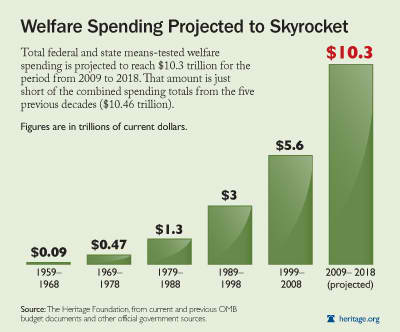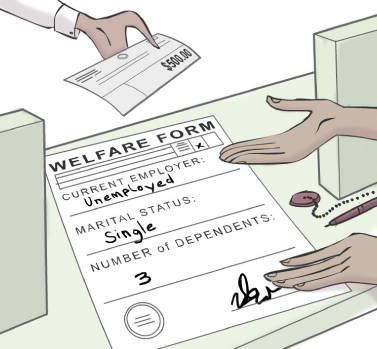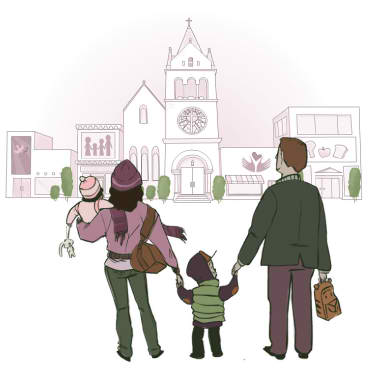What causes poverty in America?
If you’re like most people, you are concerned about poverty—but probably not your own. By historical standards, most Americans are quite wealthy. And that’s part of what bothers us. If we were all poor, we might think that’s just the way things are, but when millions of us are doing quite well while others languish in poverty, it seems that something is just not right.
Today, 39 million people in America live in households with incomes below the poverty threshold, and over 13 million of those who live in poverty are children.[1] Naturally, that makes us want to do something to help. The question is: How can we best help?
How Not to Help the Poor
Throughout most of American history, religious and other private organizations provided most of the help for the disadvantaged. Because these charities tended to be small and local, they could maintain accountability with the recipients of aid and could provide a personal response to their needs. Moreover, this outreach typically provided a foundation of values that could be uniquely effective in addressing poverty that is related to behavior and life choices.
By the early 20th century, however, the government was taking on more “social service” activities. Regrettably, this government “welfare” crowded out charities that dispensed aid within a moral and religious framework and became the more dominant supplier of social welfare assistance in America.
The welfare state as we know it began in the 1930s under President Franklin D. Roosevelt. Though welfare was initially intended as a means to end the Great Depression, its roots deepened and its duration lengthened.[2] From that beginning nearly 80 years ago, the welfare system has ballooned to over 77 different federal programs, most of which were initiated in the mid-1960s with President Lyndon Johnson’s War on Poverty, a part of his Great Society agenda.

The total cost of these welfare programs is staggering. In fiscal year 2010, the government is expected to spend almost $900 billion on welfare programs, exceeding the entire cost of the war in Iraq during George W. Bush’s presidency.[3] This immense expenditure is not the result of a temporary, short-term surge: It is the product of a steady four-decade growth in spending.
Since the beginning of the War on Poverty in 1965, the U.S. has spent $15.9 trillion on welfare. Perhaps this price tag wouldn’t be so daunting if the welfare system actually reduced poverty. Unfortunately, it hasn’t. To the contrary, under the system, the ranks of the poor have continued to swell and welfare dependence has spread dramatically.[4] While the caseload of the Aid to Families with Dependent Children (AFDC) program was just under a million in 1964, by 1995 it had risen to 4.8 million. Why?
The Welfare Trap
More than 77 government welfare programs—which are spread across several federal departments and provide cash, food, housing, medical care, and targeted social services to poor and low-income persons—are “means-tested.” That is, beneficiaries qualify if they are below a specified income level.
A Recipe for Creating Poverty
Jack F. Kemp
What if you wanted to create poverty. What policies and principles would you use to destroy the economy of cities and make people dependent on government? How would you do it? Let me offer some suggestions:
- Impose steeply graduated and progressive tax rates and then inflate the currency to push people into ever higher tax brackets;
- Reward welfare and unemployment at a higher level than working and productivity;
- Tax the entrepreneur who succeeds in the legal capitalistic system much higher than in the illicit underground economy;
- Reward people who stay in public housing more than those who want to move up and out into private housing and homeownership;
- Reward the family that breaks up rather than the family that stays together;
- Encourage debt, borrowing, and spending rather than saving, investing, and risk-taking;
- But most of all, if you really wanted to create poverty and dependency, weaken, and in some cases destroy, the link between effort and reward.
…The poor don’t want paternalism, they want opportunity—they don’t want the servitude of welfare, they want to get jobs and private property. They don’t want dependency, they want a new declaration of independence. 5
Excerpted from a speech by the late Jack Kemp, former Housing and Urban Development (HUD) Secretary, at The Heritage Foundation, June 10, 1990.
Regardless of their intention, means-tested programs by their very nature pose disincentives for households to increase their incomes and risk termination of their benefits. Thus, the welfare system effectively set up roadblocks to the two main avenues for economic progress: marriage and employment. A single mother would be ensured of her benefits package as long as she did not take a job or marry an employed husband. Given this scenario, it’s not surprising that dismal societal trends have followed.
Unwed childbearing is the major cause of child poverty in America. Since 1965, the rate of unwed births has soared from 7 percent to 39 percent (and among blacks, to 69 percent). Children born and raised outside marriage are nearly seven times more likely to live in poverty than children born to and raised by a married couple. Moreover, unwed childbearing is concentrated among low-income, less educated women in their early 20s—those who have the least ability to support a family by themselves.

Low levels of parental work is the second major cause of child poverty in the United States. In a typical year, only about one-fourth of all poor households with children have combined work hours of adults equaling 40 hours a week. The typical poor family with children is supported by only 800 hours of work during a year, an average of 16 hours of work per week. If work in each family were raised to 2,000 hours per year—the equivalent of one adult working 40 hours per week through the year—nearly 75 percent of poor children would be lifted out of poverty.[6]
How Reforming Welfare Reduced Dependence
The Welfare Reform Act of 1996 reduced some of these damaging incentives in one major program, Aid to Families with Dependent Children. Under AFDC, states were given more federal funds if their welfare caseloads increased, and funds were cut whenever the state caseload fell. In other words, states were basically encouraged to swell their welfare rolls.

Welfare reform replaced AFDC with a new program, Temporary Assistance to Needy Families (TANF), which provided incentives to move recipients toward self-sufficiency. Funding to each state remained constant regardless of the size of caseloads, and states were allowed to retain savings from caseload reductions.
In addition, states were required to have at least half of their welfare recipients engaged in work or activity that would prepare them for employment. Rather than anticipating depending on the government indefinitely, recipients were limited to five years on the welfare rolls. (Under the old AFDC program, recipients spent an average of 13 years on the rolls.) These reforms in funding structure and incentives made a substantial difference.
Despite dire predictions by opponents of reform that work requirements and benefit limitations would lead to a surge in poverty, just the opposite occurred. States had the flexibility to design programs that best fit the needs of their constituents. State welfare agencies were transformed overnight into job placement centers, while social workers helped recipients access child care, housing, transportation, or other support that was necessary to move them into jobs and toward self-sufficiency.
Progress Toward Work and Self-Sufficiency in Jeopardy
One would hope that after the remarkable success of reform following the reform of the Temporary Assistance to Needy Families (TANF) program similar reforms would be incorporated into the welfare system’s remaining 70-plus programs, but that hasn’t been the case. Even worse, we are now moving away from such common-sense measures even in the TANF program. The dramatic reduction in welfare dependence and child poverty that was generated by the 1996 reform is now in jeopardy.
Critical work requirements in the TANF program have been seriously undermined over the past half-decade. In addition, a policy change tucked into the massive 2009 “stimulus” bill virtually abolishes the history-making reform: For the first time since 1996, states will be rewarded for increasing their caseloads and adding to the ranks of their dependents. With this troubling shift in the wrong direction, rather than receiving a temporary hand up and access to the threshold of economic mobility and the dignity of employment, thousands of low-income families could once again be left to remain in a state of dependence and intergenerational reliance on the government.
Within 10 years, welfare caseloads shrank by more than half: 2.7 million fewer families were dependent on welfare checks. As the welfare caseloads fell, the employment of single mothers surged upward, and 1.6 million fewer children were living in poverty.[7] In 2001, despite the recession, the poverty rate for black children was at the lowest point in America’s history.[8]
Other Venues to Reduce Poverty
The 1996 welfare reform provided a model of how structural reform in government programs can reverse practices that had once maintained and even exacerbated poverty. Yet an effective, comprehensive response to poverty in the United States must go beyond reforms in the government’s delivery system of benefits. It will require efforts by policymakers and citizens that focus on underlying behavior and life choices related to poverty, tapping the resources of social institutions and creating an economic environment that is conducive to growth, upward mobility, and prosperity.
First Responders to Poverty
At their roots, the problems of poverty are relational and complex, and effective responses focus on restoring relationships from the ground up. That means individuals, families, churches, and ministries are best equipped to be first responders to those in need because they can deal with the whole person, face-to-face. People need food, shelter, and clothing, but they also need relationships that offer love and accountability and that address the transcendent aspects of human existence.
Getting personally involved with another individual’s or family’s needs is a lot tougher than writing a check or signing a petition. Though those actions can be necessary and important, personal outreach and investment make a difference on a much deeper level. Serving others isn’t always safe, comfortable, or immediately effective. But when we exercise personal responsibility for the wounded neighbor in our midst, we can promote the human dignity of those we serve by recognizing their spiritual and relational—not only financial and material—needs.
Excerpted from lesson six of Seek Social Justice: Transforming Lives in Need, a new DVD small group study guide from The Heritage Foundation. Visit SeekSocialJustice.com to order free copies.
Strengthening the Institutions of Civil Society
Churches and charities are often closer to the problem and have a firsthand understanding of the needs of the people they serve. They tend to treat recipients not merely as mouths to feed or “heads in beds” to tally, but rather to appreciate the people they serve as unique individuals with emotional, relational, and spiritual as well as material needs.
In contrast to bureaucratized government programs, community and faith-based organizations can provide a moral and spiritual framework that can serve as a foundation for the transitions in behavior and choices that many individuals must make to begin their journey to self-sufficiency. Often based in the neighborhoods they serve, such groups are frequently more accountable both to their donors and to those they serve than are large, anonymous government programs.
Transforming Lives in Need
Bob Woodson is founder and president of the Center for Neighborhood Enterprise, which has offered support and training to more than 2,000 grassroots leaders since 1981. He dubs these community servants as “Josephs,” counterparts to the biblical figure who guided the Pharaoh through dangers that his court advisors could not foresee:
The answers to many problems America faces can be found in our own modern-day Josephs. Many of these community healers have come out of our prisons. They have experienced what it is to live in drug-infested, crime-ridden neighborhoods. Many have, themselves, fallen but have been able to recover through their faith in God. Their authority is attested to, not by their position and prestige in society, but by the thousands of lives they have been able to reach and change….They embrace the worst cases and they work with meager resources, yet their effectiveness eclipses that of conventional professional remedies….The undeniable fact that lives have been transformed through the work of modern-day Josephs must be appreciated even by observers who may be skeptical about their approach.
Robert L. Woodson, Sr. The Triumphs of Joseph: How Today’s Community Healers Are Reviving our Streets and Neighborhood
In some cases, men and women who provide private-sector outreach have personally and successfully confronted a problem that had led to impoverishment. This experience allows them to win the respect and response of the people they serve, giving them “street cred,” and inspires their commitment to help others.
For example, throughout the nation, the outreach of former gang members has transformed and salvaged the lives of adolescents who were headed down a path of violence.[9] Those who have overcome addiction or faced the challenges of single parenthood have motivated and guided their counterparts to achieve similar success.[10] Such community servants and others motivated by their faith and compassion have provided the consistent, personal long-term outreach—far beyond the life of a typical program or grant term—that has made a substantial and sustainable difference in the lives they’ve touched.
More often than not, material poverty in the U.S. is a symptom of some prior relational problem. Consider, for example, the fact that thousands of people in America spend any given night on the street. What we need to know is not merely how many people are homeless, but why. In many cases in the United States, the root causes of the plight of the dispossessed are ultimately not economic, but rather such factors as mental illness, drug and alcohol addiction, abuse, or abandonment. Personal ongoing contact and commitment is necessary to identify and address each individual’s unique spectrum of needs.
Offering that outreach, faith-based and community efforts that deal comprehensively and specifically with the unique situations of the individuals they serve are typically more successful than their government-run counterparts, which must treat people much more generically and in terms of material needs alone.[11] If dispensing food stamps and checks from Washington could cure poverty, we would have discovered that several trillion dollars ago.
Encouraging Strong Marriages
When it comes to child poverty, the decline of marriage is the topic that people seem to avoid mentioning. Yet decades of research have brought forth incontestable evidence that the decline of the family and marital dissolution are strongly linked to the financial status and long-term prospects of women and their children.
Marriage isn’t exclusively a values or social issue; it’s also an economic issue (the economic issue as far as children are concerned). When compared to counterparts raised by two married biological parents, children raised in single-parent homes are far more likely to live in poverty and more likely to end up on welfare in adulthood. They also are more likely to fail in school, abuse drugs or alcohol, become pregnant as teens, suffer from emotional and behavioral problems, and end up in jail as adults.[12]
The Facts: Why Marriage Matters
The results of decades of research on the impact of family structure on economic well-being are presented at FamilyFacts.org, including the following findings:
- Married couples are less likely than cohabiting couples to be in poverty.[13]
- Children living with married parents are less likely to live in poverty than peers in other family structures.[14]
- On average, married mothers have much higher per-capita family incomes than peers who are divorced, single, or cohabiting.[15]
- Married men tend to have higher incomes than men in cohabiting relationships—as much as twice as high.[16]
On average, married-couple families accumulate significantly more assets than female-headed households—as much as nearly four times more.[17]
The good news is that a large percentage of unmarried mothers have some prospect for marriage at the time of their babies’ birth. Nearly half of the women who give birth outside of marriage are cohabiting with the baby’s father. Another 25 percent are in a romantic relationship with the father. In these situations, both parents tend to have positive attitudes toward marriage but don’t think it is important to be married or in a stable relationship before having children.
Contrary to stereotype, most of the non-married fathers-to-be are employed; on average, their earnings are higher than the mothers’. In fact, if poor single mothers simply married the fathers of their children, almost three-quarters would immediately be lifted out of poverty.[18]
Regrettably, most non-married fathers leave the mother a few years after the child’s birth. This means that if pro-marriage messages reached the couple at the critical time just after their baby is born, life prospects for both the mother and child could be significantly changed.

Civic institutions, including churches, synagogues, and supportive community entities, can and do provide positive role models and promote the cultural traditions and mores that discourage unwed childbearing. In addition, government policy and programs could be designed to promote healthy marriages (or at least not undermine the institution of marriage), especially in low-income communities where family dissolution has taken its greatest toll. For instance, the government could reduce the anti-marriage penalties embedded in means-tested welfare programs.
The welfare system effectively set up roadblocks to the two main avenues for economic progress: marriage and employment.
Young low-income couples should have access to life-skills training to plan more realistically for the challenges of conception, childbirth, and child rearing. Education and counseling should be offered on a voluntary basis to young adult women who are at risk of non-marital pregnancy and childbearing, with a focus on helping them understand the benefits of commitment and marriage for their children and themselves. This service could be offered through referrals from Title X birth-control clinics that provide contraceptives to more than four million low-income, young adult women each year. Public education campaigns about the value of marriage could also be initiated in low-income communities where the institution of marriage has been deeply eroded.
Any serious effort to address poverty must necessarily include initiatives to promote and sustain healthy marriages. As a Time magazine cover story recently declared:
There is no other single force causing as much measurable hardship and human misery in this country as the collapse of marriage. It hurts children, it reduces mothers’ financial security, and it has landed with particular devastation on those who can bear it least: the nation’s underclass.[19]
Facilitating Entry into the Free-Market Economy
For most Americans, the word “poverty” suggests destitution: an inability to provide a family with nutritious food, clothing, and reasonable shelter. This lack of basic needs is often referred to as “absolute” poverty. But only a small number of the 37 million persons classified as “poor” by the Census Bureau fit that description. That’s because poverty in America denotes conditions relative to the median family income in the nation. This comparative economic status is known as “relative” poverty.
While real material hardship certainly does occur in the United States, it is limited in scope and severity. Most of America’s “poor” live in material conditions that would be judged as comfortable or well-off just a few generations ago. Today, the per-person expenditures of the lowest-income one-fifth (or quintile) of households equal those of the median American household in the early 1970s after adjusting for inflation.[20]
According to the government’s own data, nearly two-thirds of households defined by the census as “poor” have cable or satellite television; 85 percent have air conditioning. Overall, the typical American designated as “poor” by the government has a car, air conditioning, a refrigerator, a stove, a washer and dryer, and a microwave, as well as two color televisions, cable or satellite TV reception, a VCR, a DVD player, and a stereo. He is able to obtain medical care. His home is in good repair and is not overcrowded. By his own report, his family is not hungry, and he had sufficient funds in the past year to meet his family’s essential needs.
It should be noted that the living conditions of the average poor American should not be taken as representing all of the nation’s poor. There is actually a wide range in living conditions among the poor. For example, although nearly 60 percent of “poor” households have cell phones and a third of them have answering machines, approximately one-tenth have no phone at all. While the majority of poor households do not experience significant material problems, roughly a third do experience at least one problem during the year such as overcrowding, temporary food shortages, or difficulty getting medical care.
If poverty were measured with regard to the median standard of living and income worldwide, America’s poor are comparatively well-off, materially speaking. One-third of deaths around the world—some 18 million people a year or 50,000 per day—are due to poverty-related causes, which have been virtually eliminated in the U.S.[21] In the developing world, some 1.4 billion people (one in four) have incomes estimated below $1.25 a day.[22]
A Tale of Two Economies
Of course, material measurements of well-being are limited. As the late Jack Kemp, former Housing and Urban Development (HUD) Secretary and a 2009 recipient of the Presidential Medal of Freedom, observed:
[T]he ultimate richness of our society is not measured in creature comforts. It’s measured in opportunity…opportunity that holds out the hope of any man, any woman, any child of God, reaching his or her potential. And having the opportunity to know the dignity and the justice that go with a good home, a good education, a chance to raise your children in a decent and honest environment, with a school that teaches them the basics and believes in character and has accountability and choice, and believes that at the end of that education, there’s going to be a job, not on the public payroll, but in the private, entrepreneurial, free enterprise system.[23]
Free markets have encouraged economic growth and led to material benefits for American society as a whole. The American system of free enterprise has created enough wealth so that we have virtually eradicated “absolute poverty” (i.e., dire material conditions) within our borders. Yet the question remains: How best do we address the relative poverty that millions of Americans experience?
The key to solving relative poverty is based on the same idea by which absolute poverty in the nation has been virtually eliminated: free enterprise. Yet, ironically, typical programs for the poor overlook this crucial vehicle for upward mobility.
This devastating irony was perhaps best described by Jack Kemp:
America is not divided immutably into two static classes. But it is separated or divided into two economies. One economy—our mainstream economy—is democratic and capitalist, market-oriented and entrepreneurial. It offers incentives for working families in labor and management. This mainstream economy rewards work, investment, saving and productivity. Incentives abound for productive economic and social behavior.…
But there is another economy—a second economy that is similar in respects to the East European or Third World socialist economies. It functions in a fashion opposite to the mainstream capitalist economy. It predominates in the pockets of poverty throughout urban and rural America. This economy has barriers to productive human and social activity and a virtual absence of economic incentives and rewards. It denies black, Hispanic and other minority men and women entry into the mainstream. This economy works almost as effectively as did hiring notices 50 years ago that read “No Blacks—or Hispanics or Irish or whatever—Need Apply.”
The irony is that the second economy was born of desire to help the poor, alleviate suffering, and provide a basic social safety net. The results were a counterproductive economy. Instead of independence, the second economy led to dependence. In an effort to minimize economic pain, it maximized welfare bureaucracy and social costs.[24]
Kemp did more than issue a clarion call demanding a new paradigm to address the poor that could lead to self-sufficiency and even prosperity: He translated that ideal into action. As HUD secretary, he launched the Office of Resident Initiatives, which empowered a nationwide band of hundreds of visionary and committed public housing residents to manage the properties in which they lived. His philosophy guided the design of policies and programs that would engender self-sufficiency and upward mobility for the poor:
class="insettext">We do need security in the form of a safety net under which people—the poor, the disadvantaged, the handicapped, those who, for one reason or another, cannot compete—will not fall. We must not only…protect the safety net for all people in this country who are in need; we must also [provide] a ladder—the ladder of opportunity.[25]
To read more on these topics, see:
- Robert Rector, “Understanding and Reducing Poverty in America,” Testimony before the Joint Economic Committee, United States Senate, September 25, 2008, at http://www.heritage.org/Research/Welfare/tst040209b.cfm.
- Jennifer A. Marshall, Robert Lerman, Barbara Dafoe Whitehead, Hon. Wade Horn, and Robert Rector, “The Collapse of Marriage and the Rise of Welfare Dependence,” Heritage Foundation Lecture No. 959, August 15, 2006, at http://www.heritage.org/Research/Welfare/hl959.cfm.
- Robert Rector, “Welfare Reform and the Healthy Marriage Initiative,” Testimony before the Subcommittee on Human Resources of the Committee on Ways and Means, U.S. House of Representatives, February 10, 2005, at http://www.heritage.org/Research/Welfare/tst021005a.cfm.
- Robert Rector, Katherine Bradley, and Rachel Sheffield, “Obama to Spend $10.3 Trillion on Welfare: Uncovering the Full Cost of Means-Tested Welfare or Aid to the Poor,” Heritage Foundation Special Report No. 67, September 16, 2009 at http://www.heritage.org/Research/Welfare/sr0067.cfm.
- Robert Rector and Katherine Bradley, “Stimulus Bill Abolishes Welfare Reform and Adds New Welfare Spending,” Heritage Foundation WebMemo No. 2287, February 11, 2009, at http://www.heritage.org/Research/Welfare/wm2287.cfm.
- Robert Rector, “How Poor Are America’s Poor? Examining the ‘Plague’ of Poverty in America,” Heritage Foundation Backgrounder No. 2064, August 27, 2007, at http://www.heritage.org/Research/Welfare/bg2064.cfm.
- Christine Kim and Robert Rector, “Welfare Reform Turns Ten: Evidence Shows Reduced Dependence, Poverty,” Heritage Foundation WebMemo No. 1183, August 1, 2006, at http://www.heritage.org/Research/Welfare/wm1183.cfm.
- Jay W. Richards, Money, Greed, and God: Why Capitalism Is the Solution and Not the Problem (San Francisco: HarperOne, 2009), chapters 2 and 4.



